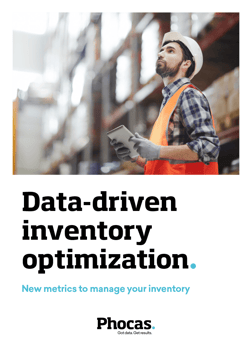The future of wholesale distribution is in your data

The distribution of goods is a vital part of the global economy. Nonetheless, as wholesale markets continue to be disrupted, it’s more difficult for distributors to remain competitive. However, data is a great equalizer. Wholesale distributors must take advantage of the wealth of information being generated by their companies each day, and turn it into actionable insights.
Building a data driven culture
Phocas has considerable experience helping wholesale distribution companies better understand their data. We have used this experience to develop a three-step process to ensure that our customers can build a strong data-driven business strategy.
Step 1: Identify your data sources: The first step is to identify the data you want to analyze. For instance, you may want the ability to analyze your ERP, financial, and purchasing data. If so, you will need the ability to combine disparate data into a single source. This way you will have a 360-degree view of your company.
Step 2: Measure, predict and optimize the outcomes from your data: With today’s technology, data is accessible to everyone. At Phocas, we recommend selecting a vendor that offers intuitive, easy-to-use, industry-specific analytics software. This includes customizable dashboards and pre-built alerts developed with the standard KPIs distributors need to measure and optimize your data.
Step 3. Adapt your business to do what the data analysis recommends: Finally, you must develop a data-driven company culture. If your management team leads by example, your employees will see that data insights lead to better decision-making. As users mine insights from your data, they will quickly develop a common language leading to a data-driven culture.
New ways to review metrics
In light of fierce competition, it is essential that wholesale distributors have visibility throughout their entire business. At Phocas, we’ve identified many important distribution metrics which come with the software. Below is one of these metrics that helps determine customer profitability.
Customer profitability Low-profit customers can come at a high cost, so it’s critical to have an accurate assessment of your customers to minimize at-risk relationships. A customer profitability analysis uses your customer purchasing data to determine their profitability.
At Phocas, we have pinpointed specific elements that affect profitability such as sales volume and cost-to-serve and developed a means to weigh these variables so companies can rank customers by their level of profitability. The following are the KPIs of cost to serve:
- Order sizes and frequency of orders: This metric impacts your inventory and handling costs. Frequent small orders incur higher sales administration costs than less frequent and larger orders.
- Accounts receivable: The cost to extend credit to a customer is determined by your own capital sources. A customer’s payment history is key to extending credit and payment history.
- The rate of returns and exchanges: Customers that frequently return or exchange items cost more due to additional handling and restocking expenses.
- Sales administration: This is the cost of sales and service calls. Customers that require multiple sales visits, or place multiple orders, cost more than customers that place orders in a single batch.
- Shipping or delivery: Customers that place multiple orders or require same-day delivery increase your delivery costs.
The changing needs of customers
Smartphones have changed the way we communicate and do business. Instead of calling, we text. And instead of using a computer, many companies manage their businesses from their phones and tablets. According to research from Google, mobile technology drives or an average of more than 40 percent of revenue, especially in industries such as distribution that depend more on sales than marketing to drive revenue.
Some of Phocas’ distribution customers now offer self-service portals so their customers can make mobile purchases and directly monitor their accounts. This channel has become a preferred method for re-ordering. Now sales reps only visit when they have a new product or a change in service. Providing customers with mobile accessibility from any device can give distributors the edge over their competition.
At Phocas, we’ve worked with distributors for nearly 20 years. Phocas makes it simple for users, regardless of skill level, to review metrics and find actionable insights and determine the best course of action for your customers and your company. With Phocas, your data becomes the common language of your business.
To read more about the many facets of data analytics in wholesale distribution download the eBook, Data-driven inventory optimization.

Empowering businesses with intuitive data analytics, driving informed decisions for growth and profitability. We make people feel good about data.

When to use an operating budget for more detailed planning
What is an operating budget? An operating budget is a resourceful tool that enables businesses to estimate income projections and expected expenses and plan for low-earning or high-spending months. This financial plan provides data that constantly records the costs of your business operations for a specific period (mainly up to the end of the year). It also serves as an outline detailing how much money a company spends and incurring expenses.
Read more
Improve planning with comprehensive sales forecasting
If the owner of your business wants to expand to a new State, would you have the sales forecasting figures to know whether the business can afford to do that or not? Or, if you had to produce a 3–year solvency projection for the CEO, is your sales forecasting process robust enough to support a reliable analysis?
Read more
Financial statement analysis: what's changing?
Financial statements are scorecards for businesses, allowing the finance team to interpret and analyze financial performance.
Read more
We'll do the data wrangling, you do the analyzing
In today’s business world, we are faced with the constant struggle to bring our data into line. The sheer volume of data that businesses generate can be overwhelming to simply manage, never mind analyze. A survey by Phocas revealed that 60% of businesses identified ‘no expertise in-house,' and 33% said, ‘too much data to unravel' as the main obstacles that prevent them from breaking down data silos.
Read more
Find out how our platform gives you the visibility you need to get more done.
Get your demo today